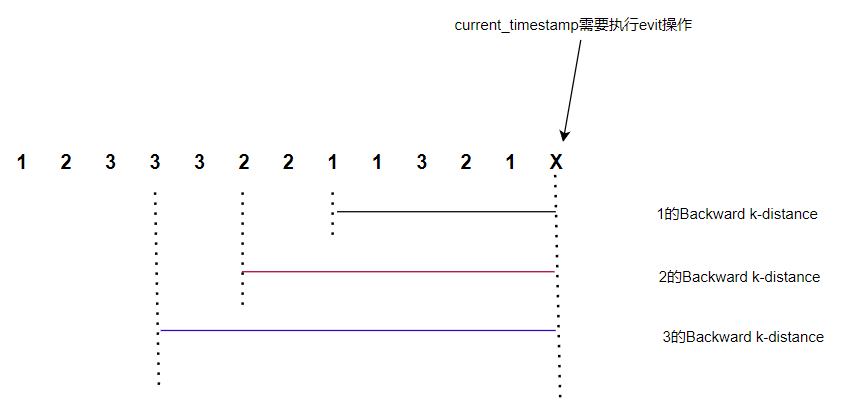CMU445-Project1-LRU-K总结
https://15445.courses.cs.cmu.edu/fall2022/project1/
DB的Buffer Replacement Policies中的LRU和Clock算法都容易受到sequential flooding的影响,对于LRU来讲,使用LRU-K算法能够缓解这个问题。
LRU-K
- This component is responsible for tracking page usage in the buffer pool.
- The LRU-K algorithm evicts a frame whose backward k-distance is maximum of all frames in the replacer.
- Backward k-distance is computed as the difference in time between current timestamp and the timestamp of kth previous access.
- A frame with less than k historical accesses is given +inf as its backward k-distance.
- When multipe frames have +inf backward k-distance, the replacer evicts the frame with the earliest timestamp.
Backward k-distance
这个数据很关键,也很容易被理解错,下面举例说明,当k=3时候

由上面的定义可知,Backward k-distance为current_timestamp和倒数第k次访问的时间之差,故k=3时候如上面所示
因为每次current_timestamp都是一样的,所以其实直接看第k次访问的时间点就好,这里可以不用记下每次访问的时间戳,直接记录访问对应的index就好了,也就说记住某个数在第几次出现就好了。
Evit
每次都选择最大的Backward k-distance驱除(evit),这里存在两种情况:
某个数已经有了k次访问记录,那么Backward k-distance就是上图所示
如果不够k次访问,那么Backward k-distance就是正无穷大
那么每次evit时候肯定都是优先选择第二种情况,因为是正无穷大
- 如果有多个无穷大,则按照FIFO的顺序evit
比如访问顺序如下(从左到右依次访问),假设k=31 2 3 4 1 2 3 1 2
这里无限大的数有3和4,按照FIFO顺序,3第一次出现的时间点和4还早,所以第一次evit时候选择3
- 如果有多个无穷大,则按照FIFO的顺序evit
- 第二种情况没有了的话,则按照第一种情况,这里直接看哪个数倒数第k次最早出现就好了,那么就是Backward k-distance最大的
SetEvictable
需要注意的是某个数是evitable才能被evit,也就是`这个函数的作用,因为此时某个数据正在被访问,不能evit
有一种情况是SetEvictable时候,但是这个数还没有被访问过或者是被evit了,那么这个函数直接return就好了
Implementation
我是使用了两个顺序容器和一个map
map记录了某个数第n次访问的index,比如hist(1, 3),代表1这个数第3次访问的index
当某个数还没有访问k次时候,就放到第一个容器,保证容器内的顺序是FIFO的,这样每次从队首或者队尾出队就好了,因为某些数可能不是Evictable的,实际上需要遍历一下容器,找到第一个能够Evictable的。
如果达到k次,那么把这个数从第一个容器挪到第二个容器
evit时候,如果第一个容器已经是empty的,那么代表没有正无穷的数,需要从第二个容器拿,此时因为map记录了每次容器出现的时间点,按照map对容器排序后直接取好了。这里没有想到一个方法类似第一个容器那么维护状态,考虑一下访问顺序:
1
1 1 1 2 2 2 1 X
虽然1是最后evit的,但是按照Backward 3-distance来看,1才是要evit,不能每次访问就更新那个数在第二个容器的位置。
看了下discord的讨论,有比这个更快的方法,应该使用了堆之类的容器维护
维护某个数是否已经出现,以及其状态:
1 | struct LruEntry { |
第一个容器:
1 | std::list<frame_id_t> less_than_k_frames_; |
第二个容器:
1 | std::vector<frame_id_t> more_than_k_frames_; |
记录每个数每次出现的时间点:
1 | struct PairHash { |
获取某个数第k次出现的时间:1
2
3
4auto GetLastKAccessTime(const frame_id_t x) const -> size_t {
const auto last_k = lru_entry_hash_.at(x).access_count_ - k_ + 1;
return hist_.at(std::make_pair(x, last_k));
}
按照Backward k-distance对第二个容器排序:1
2std::sort(more_than_k_frames_.begin(), more_than_k_frames_.end(),
[&](frame_id_t a, frame_id_t b) { return GetLastKAccessTime(a) < GetLastKAccessTime(b); });




